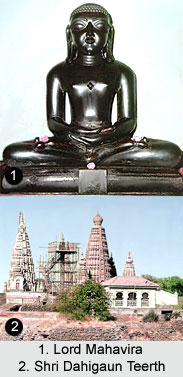 Shri Dahigaun Teerth located in Maharashtra is a Jain pilgrimage centre. The teerth kshetra is situated in the centre of Dahigaun. The temple is dedicated to Lord Mahavira, the twenty-fourth Tirthankara.
Shri Dahigaun Teerth located in Maharashtra is a Jain pilgrimage centre. The teerth kshetra is situated in the centre of Dahigaun. The temple is dedicated to Lord Mahavira, the twenty-fourth Tirthankara.
History of Shri Dahigaun Teerth
According to history Shri Dahigaun Teerth dates back to the ancient times. It is believed that devotees visiting this temple can get rid of all physical ailments and mental agonies by meditating on the idol of the temple. The foot images of His Holiness Mahattisagarji Maharaj Saheb can be seen here. They were installed in the year 1889 of the Vikram Samvat Era. Since its construction the temple has been repaired and renovated in the year 1910. The idol of Lord Mahavira was installed by Pandit Gunachandraji. The idol of Lord Mahavira is believed to possess miraculous powers. Devotees from far off places visit the temple to offer their prayers and get their wishes fulfilled.
Temple of Shri Dahigaun Teerth
The temple of Shri Dahigaun Teerth houses the idol of Lord Mahavira. The temple has been magnificently decorated with intricate artistic designs. The creative temple work boast about the skills of the craftsmen. The walls of the temple have been tastefully painted and decorated with ancient paintings. These attractive paintings enhance the beauty of the temple. Apart from this there are many oil paintings of many Digambara Acharyas that adorn the temple. The idol of the Lord is nearly 244 cm in height and is black in colour. It is seated in a padmasana posture. The look of the idol is very calm and serene.
The Temple of Shri Dahigaun Teerth organises many annual gatherings and functions. Every year a fair is held here on the fifteenth day of the bright half of the month of Kartika. There are provisions for dharamshalas or rest houses for the pilgrims. These are well equipped with all modern facilities. The temple is enclosed by scenic beauty that mesmerises and fascinates the pilgrims. The calm and tranquil environment and the surrounding greenery make it a suitable place for religious activities. The kshetra is well connected to road, rail and air. Taxi services and bus services are easily available here. The nearest railway station is located at Pandharpur which is nearly at a distance of nearly 64 kilometers. The nearest village of Natapota is at a distance of nearly 7 kilometers.




















